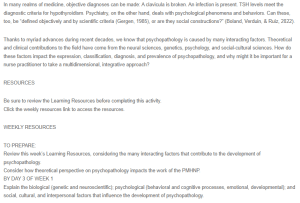The Multidimensional Integrative Model in Advanced Practice Psychiatric Nursing
Responding to Priscilla C
Hello,
Great work with your post! The multidimensional/integrative model of psychopathology is useful for Advanced Practice Nurses since it enhances understanding of mental health disorders from biological, psychological, and social perspectives. Recognizing that there are factors such as the genes, environment, and emotional state involved in mental disorders is helpful in the treatment process. Nurses develop individualized care plans based on each client’s needs, considering how different aspects that define a person interconnectedly affect their mental health (Schiele et al., 2020). Thus, by adopting this integrative approach, advanced practice nurses will be able to discover the nature of the disorder and apply better means of handling the problem, thus enhancing the well-being of the patients. It also helps in appreciating the need for early intervention, which is critical in eradicating lasting mental health issues, as proposed by Luby et al. (2021). Integrating these factors guarantees nurses’ comprehensive and productive clinical interventions.
References
Luby, J. L., Rogers, C., & McLaughlin, K. A. (2021). Environmental conditions to promote healthy childhood brain/behavioral development: Informing early preventive interventions for delivery in routine care. Biological Psychiatry Global Open Science, 2(3). https://doi.org/10.1016/j.bpsgos.2021.10.003
Schiele, M. A., Gottschalk, M. G., & Domschke, K. (2020). The applied implications of epigenetics in anxiety, affective and stress-related disorders – A review and synthesis on psychosocial stress, psychotherapy and prevention. Clinical Psychology Review, 77(3), 101830. https://doi.org/10.1016/j.cpr.2020.101830
Responding to Lauritta O. Orubele
Hello,
Thank you for sharing your post. Adopting a multidimensional, integrative model of psychopathology is crucial for advanced practice nurses because it provides a holistic view of mental health disorders (Ee et al., 2020). This model involves interacting aspects like genetic and neural components with the psychological and social elements, as Kalin (2020) supports. By incorporating all these aspects, advanced practice nurses can develop more targeted and effective treatment strategies. This comprehensive approach of systematic formal assessment guarantees that all the aspects are covered before making any diagnosis or commencing treatment of mental health disorders, hence enhancing medical solutions for the patients. The integrative model also supports the identification of potential comorbidities and the development of preventative strategies, which are essential for long-term mental health management, thereby improving overall patient outcomes.
References
Ee, C., Lake, J., Firth, J., Hargraves, F., Manincor, M. de , Meade, T., Marx, W., & Sarris, J. (2020). An integrative collaborative care model for people with mental illness and physical comorbidities. International Journal of Mental Health Systems, 14(1), 1–16. https://doi.org/10.1186/s13033-020-00410-6
Kalin, N. H. (2020). Early-life environmental factors impacting the development of psychopathology. American Journal of Psychiatry, 177(1), 1–3. https://doi.org/10.1176/appi.ajp.2019.19111181
ORDER A PLAGIARISM-FREE PAPER HERE
We’ll write everything from scratch
Question
In many realms of medicine, objective diagnoses can be made: A clavicula is broken. An infection is present. TSH levels meet the diagnostic criteria for hypothyroidism. Psychiatry, on the other hand, deals with psychological phenomena and behaviors. Can these, too, be “defined objectively and by scientific criteria (Gergen, 1985), or are they social constructions?” (Boland, Verduin, & Ruiz, 2022).

The Multidimensional Integrative Model in Advanced Practice
Thanks to myriad advances during recent decades, we know that psychopathology is caused by many interacting factors. Theoretical and clinical contributions to the field have come from the neural sciences, genetics, psychology, and social-cultural sciences. How do these factors impact the expression, classification, diagnosis, and prevalence of psychopathology, and why might it be important for a nurse practitioner to take a multidimensional, integrative approach?
RESOURCES
Be sure to review the Learning Resources before completing this activity.
Click the weekly resources link to access the resources.
WEEKLY RESOURCES
TO PREPARE:
Review this week’s Learning Resources, considering the many interacting factors that contribute to the development of psychopathology.
Consider how theoretical perspective on psychopathology impacts the work of the PMHNP.
BY DAY 3 OF WEEK 1
Explain the biological (genetic and neuroscientific); psychological (behavioral and cognitive processes, emotional, developmental); and social, cultural, and interpersonal factors that influence the development of psychopathology.
Upload a copy of your discussion writing to the draft Turnitin for plagiarism check. Your faculty holds the academic freedom to not accept your work and grade at a zero if your work is not uploaded as a draft submission to Turnitin as instructed.
Read a selection of your colleagues’ responses
BY DAY 6 OF WEEK 1
Respond to at least two of your colleagues on 2 different days by explaining the implications of why, as an advanced practice nurse, it is important to adopt a multidimensional, integrative model of psychopathology.

